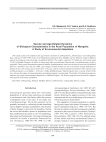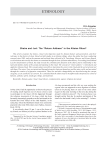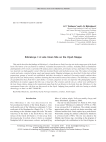Archaeology, Ethnology & Anthropology of Eurasia @journal-aeae-en
Статьи журнала - Archaeology, Ethnology & Anthropology of Eurasia
Все статьи: 524
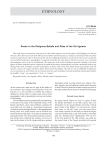
Rocks in the religious beliefs and rites of the Ob Ugrians
Статья научная
This study, based on materials collected in the 18th–20th centuries, and on the author’s field findings over the last 40 years, shows the role of rocks in the Ob Ugrian worldview and ritual practices. Evidence is provided on the veneration of various natural stone objects. Reasons for the cult of worshipping such places are discussed. One reason was that the rock resembled a human or animal figure. In legends and myths, the stone houses of heroic ancestors were correlated with numerous caves in the Ural Mountains. The main part of the article introduces materials relating to the stone figures of deities and patron spirits, supported by mythical narratives explaining the ways that a mythological hero was changed into stone. Examples are given of the figures of deities with a stone base found among local groups of the Ob Ugrians, such as the Lyapin and Sosva Mansi, Synya and Polui Khanty. The role of rocks in childbirth and funerary rites is examined, as well as their role in economic practices such as fishing. In Khanty and Mansi mythological beliefs, the modifier «stony» was equivalent to «iron» or «strong».
Бесплатно
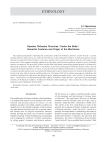
Russian Orthodox churches “under the bells”: semantic features and origin of the worldview
Статья научная
The religious foundations underlying the construction of Russian Orthodox churches “under the bells”, and the meaning and role of this notion, are analyzed with reference to the traditional worldview. Architectural features of such churches are described. They belong to a rare type, and have been constructed in Russia from the 14th century to the present time. Their multiple meanings, influenced by Byzantine and European traditions, related to the key Orthodox notions, are analyzed. The most basic of these was the idea of the ladder, symbolizing spiritual growth, as evidenced by dedication of churches “under the bells” to the Stylites, to preachers developing key Orthodox notions, and to converts engaged in spiritual maturation, as well as to miracles believed to influence human life in a profound way. Dedications to miracles and miraculous icons, associated with military glory, and to canonized warriors, patrons of the military, are based on the idea of the victorious and life-giving cross. The image of the bell as a divine messenger is embodied in the tradition of placing bells right above the liturgical space, making perception of the “voice of God” by the flock more direct. A conclusion is reached that the pillar-like edifices of churches “under the bells” represent the most meaningful elements of the Russian worldview, marking the Orthodox cultural landscape, whose central idea is that of spiritual maturation and triumphant Christian faith.
Бесплатно

Sanctuary with “Kalguty” style images in northwestern Mongolia (preliminary data)
Статья научная
This article presents the first results of a detailed study of a key rock art site with the earliest petroglyphs in the Mongolian Altai—Baga-Oigur-5 (Right Bank). Basic data on its location, the surrounding environment, etc. are provided. The main groups of petroglyphs are characterized and attributed. The most numerous group, that of the "Kalguty" style, is examined in detail. This style was previously attributed by the current authors to the Final Upper Paleolithic. Bronze Age and medieval petroglyphs are also present at the site. The most informative panels show single horses, bulls, sheep, and deer rendered in the "Kalguty" style, as well as compositions including these animals. Among the earliest local rock art, for the first time, a nonfigurative sign has been found, resembling a grid, connected with the figure of a horse in a manner that is typical of prehistoric art. The analysis of a multilayered composition—one of the most important—confirms the hypothesis that "Kalguty" style petroglyphs predate the Bronze Age. The unusual natural context of Baga-Oigur-5 (Right Bank) is addressed in detail: a restricted area with available flat rock surfaces standing out against a background landscape with convex boulders. The arrangement of rock carvings within the site is unusual: animal figures on various surfaces combine in a nearly compositional manner. A tentative conclusion is made that the site was a sanctuary.
Бесплатно
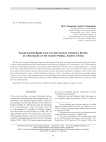
Статья
We describe a group of Egyptian faience scarabs unearthed from the necropolis on the Iluraton Plateau, Eastern Crimea, by the expedition from the State Museum of the History of Religion (St. Petersburg) in 1987–1990. Artifacts made of so-called Egyptian faience were found in eight of the sixty-two burials—those of g irls aged below 1.5, dating to the 1st to early 2nd centuries AD. The most numerous among the faience items were beads in the form of scarabs. The analysis shows them to fall into three groups in terms of presence and nature of images on the reverse side: those without images (3 spec.), those with abstract images (3 spec.), and those with anthropo-zoomorphic images (2 spec.). In two cases, representations point to specifi c Egyptian workshops. Scarabs in girls’ burials of the Roman period elaborate on the thanatological imagery, which originated among the Scythian-Saka tribes of Eurasia in the mid-1st millennium BC.
Бесплатно

Seasonality of Sintashta funerary rites (based on the Kamennyi ambar-5 Bronze Age cemetery)
Статья научная
Based on archaeological materials from the Kamennyi Ambar-5 cemetery, we test the hypothesis about the connection between the seasonality of pastoral practices and funerary rites during the Late Bronze Age (early 2nd millennium BC). We studied growth layers in the teeth of 24 cows, 19 sheep/goats, 14 horses, a dog, and ten humans from 17 graves. We combined samples from various species from the same contexts into eight assemblages. With regard to animals, differences in seasons of death were revealed only once. 70 % of graves were arranged in spring and 30 % in autumn. Therefore, the hypothesis about the seasonal use of the cemetery can be supported at least partially. The contemporaneous settlement of Kamennyi Ambar demonstrates a similar tendency in the seasonality of animal slaughtering. However, the reasons for slaughtering at the settlement differed from those in the cemetery. At the settlement site, it was motivated by practical needs, and in themortuary site, only by the seasonality of human deaths, specifically Ьy a higher frequency of deaths in late winter and spring. Also, postmortem selection is possiЬle, whereЬy kurgan burials were arranged only for some individuals. In practice, several of the above factors overlapped, resulting in an anomalous composition of the buried cohort (disproportion of sexes and a higher proportion of individuals who died at the peak of vital activity).
Бесплатно
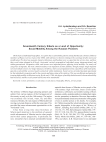
Seventeenth century Siberia as a land of opportunity: social mobility among the Russian pioneers
Статья обзорная
Бесплатно
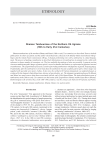
Shaman tambourines of the northern Ob Ugrians (18th to early 21st centuries)
Статья научная
Shaman tambourines of the northern Khanty and Mansi (18th to early 21st centuries) are described. Sources include publications by other specialists and the author's fi eld materials collected in the Khanty-Mansi Autonomous Okrug–Yugra and the Yamal-Nenets Autonomous Okrug. A shaman performing rites with a tambourine is called koipyng-nyait. The process of making a tambourine is described. Information on 44 tambourines is summarized in a table with reference to shape, number of resonators, etc. The few available descriptions of rites are provided. A separate section concerns anthropomorphic images of patron spirits, carved on handles and beaters or represented as figurines inserted in tambourines. The Lyapin Mansi practiced a custom of providing tambourines with figurines of guards, koipyng-pupyg. Traditionally, after the tambourine's owner had died, the tambourine became a family patron spirit, whose image was supplied with specially sewn men's clothes. In my view, the northern Ob Ugrian shamanism was underdeveloped, as evidenced by the shaman's limited functions, absence of special attire, etc. The shamanic paraphernalia used by Khanty and Mansi are much scarcer than those associated with the cult of Mir-Susne-Khum. The main distribution areas of tambourines in the 20th to early 21st centuries are the basins of the Lyapin River (Mansi) and the Synya River (Khanty). Both belonged to the territory that, in the 18th–19th centuries, was the contact zone between Ob Ugrians and Nenets.
Бесплатно

Shift of the Yenisei and Abakan Beds as Reasons for Constructing the Second Abakan Fort in 1707
Статья научная
The study explores the reasons behind the relocation of the construction site for Fort Abakan from the mouth of the Abakan River, as initially planned, to the right bank of the Yenisei River, between two mountains, Unyuk and Turan. The shift of sand ridges, damming these rivers and changing their beds, is examined, and the locations of the projected forts are described. Written sources suggest that the Abakan and Yenisei beds as related systems changed their positions simultaneously, likely between 1691 and 1697 and definitely no earlier than 700–400 BC. Modern hydrological data suggest that processes that occurred in the region in the Early Modern Age were essentially like those that occurred in the Early Iron Age. The earlier date of the Abakan bed’s change is evidenced by the destruction of the 1st millennium BC Tagar sites near Sartykov village on the Abakan. At present, the Yenisei makes an abrupt eastward turn in that place, following the general direction of rivers in the region. D.A. Klements’s idea that after leaving the Western Sayan canyon, the Yenisei had flowed westwards is rejected. The change of location for the prospective fort was caused by the evolution of riverine systems of Western Siberia, specifically by the shift in the Abakan bed.
Бесплатно
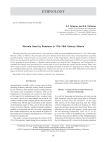
Shovels used by Russians in 17th-18th century Siberia
Статья
The study describes types of the shovel—one of the most widely used and multifunctional tools in 17th–18th century Russian culture of Siberia. The principal collection includes more than twenty intact and fragmented specimens unearthed during 13 fi eld seasons of excavations at Tara, in the Omsk Region. Shovels found elsewhere in Western Siberia are also described, and the role of this tool in the households of Russian pioneers in Siberia is assessed. Judging by the drawings in Semen Remezov’s chronicle and excavation records from Tara, Mangazeya, and Nadym forts, we conclude that shovels were specialized for various kinds of work, and that they varied with the season. There were diverse types used for constructing fortifi cations, dwellings and utility structures, for digging graves, tillage, clearing snow, handling bulk materials, and baking bread; children’s toy shovels are also described. Information is provided on shapes of shovels and the types of wood Siberians used for making them.
Бесплатно

Shulbinka Paleolithic site, Eastern Kazakhstan, revisited
Статья
This study revises the cultural and chronological attribution of the Shulbinka site, Eastern Kazakhstan, with reference to recent ideas of the Early Upper Paleolithic in northern Central Asia, including new sites dating to that stage (Tolbor-21, Ushbulak, etc.) and a representative series of absolute dates relevant to the site’s chronology. We describe the discovery of the site and principal fi ndings of excavations carried out more than 20 years ago, focusing on the comprehensive analysis of artifacts from Shulbinka, conducted in 2019. We demonstrate that the estimated age and the cultural attribution of the site disagree with earlier interpretations. Earlier claims about the presence of Levallois and Mousterian components in the primary reduction system appear poorly supported. The idea that artifacts from the site resemble those of the Early Upper Paleolithic is subjected to a critical inquiry. As it turns out, the closest parallels to this assemblage are found among the Final Upper Paleolithic industries of southern and central Siberia. Important traits include the combination of large cores for making fl akes, blades with edge-faceted and wedge-shaped microcores, and the predominance of end-scrapers and chisel-like tools. Few parallels can be found with industries of different cultural and chronological periods. Based on these analyses, we conclude that the site of Shulbinka dates to the Final Paleolithic. The absence of Final Middle Paleolithic or Early Upper Paleolithic markers makes the site irrelevant to debates around the origin of the Upper Paleolithic in the region.
Бесплатно

Статья научная
Silicate slag inclusions in iron artifacts from the Trans-Urals and in iron slags from sites of the Itkul culture were analyzed to assess the geochemical characteristics of iron ore sources exploited during the Early Iron Age. Slag inclusions were found in 19 out of 25 samples from Kichigino I and Krasnaya Gorka. For comparison, we used 12 iron slag samples from Early Iron Age and medieval sites near Lake Irtysh and from Zotino mine. Via statistical analysis, four geochemical groups were separated, each including one or more Kichigino artifacts, which suggests a variety of iron ore sources used by the nomads. Slags and artifacts of the first group are associated with infiltration-sedimentary ironstone ores of the Middle Trans-Urals. Smithing slag from the Itkul site of Shatanov V suggests that these ores were already smelted in the Early Iron Age. The fact that group 1 includes only one artifact from Kichigino I demonstrates that the nomads of the Southern Trans-Urals obtained iron mainly from other sources. Group 2 is characterized by a higher content of Mn and sometimes Ba and S in inclusions. This may attest to the use of Fe-Mn ironstone associated with barite-polymetallic deposits of Central Kazakhstan. Group 3 shows an elevated content of CaO and MgO, indicating the use of ironstone from platform carbonate strata. In the fourth group, the content of K2O is high, and that of MnO, low.
Бесплатно
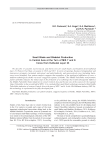
Статья научная
We describe 27 parallel, narrow-faced, and burin-cores for small blades and bladelets from Kulbulak layer 23, Western Tien Shan, excavated in 2016 and 2017. In terms of typology, flat-faced (longitudinal and transverse), prismatic (carinated, subconical, and subcylindrical), and narrow-faced cores (including burin[1]cores) were identified. Scar pattern analysis suggests that regardless of the typological affiliation of cores, a uniform technological scheme was used—staggered sequence of blanks. This Middle Paleolithic non-prismatic pattern probably indicates the initial steps in the formation of a technology that would subsequently influence the Middle Paleolithic blade industries in western Central Asia and become one of the sources for the regional Upper Paleolithic in the second half of MIS 3. It is concluded that small blade technology emerged within Middle Paleolithic industries of western Central Asia at the turn of MIS 7 and 6. In the Obi-Rakhmat industry (MIS 5a), this technology is represented in its fully developed form.
Бесплатно

Статья научная
In cultural terms, as compared to many other Russian groups, the South Russian (Kursk) settlers of Siberia in the late 19th to early 20th centuries were a distinct group, having their own traditional culture but usually no compact settlements. In this work, for the first time, on the basis of the State Archive of the Kursk Region, the ethno-cultural composition of Siberian settlers from that region is examined. Attitudes of South Russian peasants of the post-Reform era to migration are analyzed, reasons underlying their “wanderlust” and their reflection about relocation and ethnic identity are explored. Documents at the State Archive of the Tomsk Region, and the findings of my fi eld studies in 2014– 2018 pertaining to the Siberian stage in the history of Russian “Yuzhaks” (Southerners) suggest that their priority was to live side by side with Ukrainian settlers, as they had used to do in their homeland. The reason is that the key role in the early 20th century migrations was played by Russian-Ukrainian frontiersmen—people of “no man’s land”. At the time of migration to Siberia, those living in the southern Kursk Governorate were Russian Old Believers, Southern Russians, Belarusians, Ukrainians (Little Russians), Russian Cossacks, and “Cherkassians” (Ukrainian Cossacks). The latter preferred to live apart from others, even within a single village. Archival documents and findings of field studies in the Anzhero-Sudzhensky District of the Kemerovo Region, and in the Topchikhinsky and Kulundinsky Districts of the Altai Territory demonstrate that Southern Russians were situationally identical to Ukrainians, as evidenced, for instance, by the frequent shift of surname endings from “-ko” and “-k” to “-ov” and vice versa, depending on migration plans. A conclusion is made that the ethnic diversity of migrants from the Kursk Governorate, the situational equivalence of Eastern Slavic groups in Siberia, as well as marriages with Russian old residents and Ukrainians, were key factors in the formation of local Siberian variants of the South Russian culture.
Бесплатно



